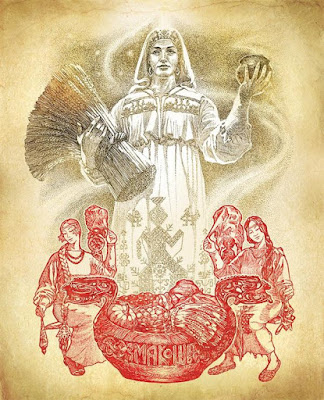Goddess Mokos was worshipped by the Eastern Slavs, but some forms of her name also appear among the Western Slavs (Mukes, Mukus, Mococize). Mokos was the goddess of spinning, but she was also a protector of women, taking care about their health and their children. She helped the women in labour and protected their babies, at the same time helping the women keep a good marriage. Besides spinning, Mokos was connected with other duties reserved for women and with household management, but spinning was the skill that was in close relation with this goddess. There were many customs concerning Mokos as the protector of the spinners.
Slavic women would throw hemp, called "mokrica" (mokar = wet), into the water. The hemp was a sacrifice offered to Mokos. Hemp yarn was not to be left over the night, lest Mokos would spin it. Another of Mokos's roles was to protect the sheep and their fleece; the Slavs made offerings to her for that reason, too. A pair of scissors, basil and a skein of wool used to be put before the feet of Mokos's statue, with the aim of insuring protection for the lambs that hadn't been shorn yet. Even after conversion to Christianity, some beliefs related to Mokos were kept. In northern Russia, there was a belief that during the Lent Mokos went from house to house supervising the spinners. It is thought that Mokos had a role similar to that of the Sudjajas (Sudjaje = the Fates). Since she was connected with spindle and distaff, it is assumed that Mokos's area of influence stretched to the cosmic plain, making her the goddess that controlled human destiny and cut the short thread of human life.
Another action related to Mokos was casting spells. The women that practiced sorcery in the 16th century Russia were called mokose. Aleksandra Bajic brings Mokosa in connection with Baba-Jaga, a witch from Russian fairy tales that lives in a cottage placed on chicken legs as foundations and helps boys and girls by giving them magic objects. A question arises, however, whether Mokos was originally a witch goddess or she became one after Christianisation.
Mokos was a goddess of the Kiev pantheon. Her statue was erected by prince Vladimir in 980 AD on a hill above Kiev, but it was pulled down by the same prince eight years later, after he converted to Christianity. How was Mokos represented? In northern Russia she was imagined as a woman having a big head and long arms. Vollmer, the historian, mentions Mokos's statue representing a figure put together from parts of different animals. Owing to that, Mokos was considered to be the goddess of ugliness, pains, troubles and human passion, but this interpretation has no foundation in the traditional ways of representing Mokos.
What can we learn from etymological analysis of Mokos's name? The name of this goddess is most frequently connected with the word mek (= soft), so she could be related to something that is soft. Since she was the spinners' goddess and the protector of the sheep, it is most probable that the adjective "soft" refers to fleece. Mokos could also be connected with the adjective mokro (= wet), which makes some authors identify her with Majka Vlazna Zemlja. This identification is certainly based on one of Mokos's characteristics – she was also seen as the goddess of fertility. The rain was therefore sometimes referred to as "Mokos’s milk". The term Mokos is also used in Finland, where it can usually be found as a surname. The Finns are thought to have taken this name over from the Slavs, or to be more precise, those whose last name is Mokos are thought to be of Slavic origin.
Mokos is sometimes identified with Vida, Svarog's wife. She was, along with Svarog, the creator of mankind, and was consequently connected with the white bee, Slavic mythical ancestor. The bee is therefore Mokos's holy animal, along with the sheep and the snake. Her plants are lime, flax and "kantarion". Lime is of course related to the first woman made of lime-wood, created by Mokos. According to Cajkanovic, flax is a plant frequently used in casting spells, whereas "kantarion" is used in treating problems connected with female reproductive organs.
Mokos's characteristics were transferred onto St. Petka. St. Petka is also the protector of women, and it is interesting to know that Vlach women frequently mention this saint while performing magic rituals. Some of them pray to St. Petka to help them perform the ritual, and she even appeared to a man to welcome him into a witch cult. Mokos's holy day is Friday – women must not spin on that day, otherwise Mokos will punish them. The festival dedicated to this goddess was celebrated some time between 25th October and 1st November, depending on which date happened to be Friday. As we know, St Petka's Day is celebrated on 27th October, and that holiday is fixed to that date, although it probably shouldn't be because Friday is dedicated to female deities Freya (Friday) and Venus (venerdì). On Mokos's holiday people would go to a lime-tree wood and make offerings usually consisting of herbs and various vegetables, but there is also a record that they sometimes sacrificed birds to this goddess.




No comments:
Post a Comment